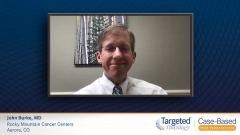
Case Presentation: Diffuse Large B-cell Lymphoma
John Burke, MD, presents a case of a 76-year-old man with relapsed/refractory diffuse large B-cell lymphoma (R/R DLBCL).
John Burke, MD: Hello, everyone. My name is John Burke from Rocky Mountain Cancer Centers. I'm Associate Chair of the Hematology Oncology Research Program at US Oncology. We are going to be talking today about diffuse large B-cell lymphoma [DLBC]). I will be presenting a case of an older patient with relapsed diffuse large B-cell lymphoma, and we are going to talk about the treatment options available in this rapidly changing field. To start with the case, we have a 76-year-old man who presents with a right inguinal mass and has constitutional symptoms of fatigue and loss of appetite. This man has a past medical history of atrial fibrillation and hypertension. On the physical exam, you notice a 5-cm right inguinal mass, bilateral axillary lymphadenopathy, and splenomegaly. His performance status is a 2, and the laboratory workup is notable for the measured hemoglobin of 9.9. The patient undergoes an excisional biopsy of the lymph node that shows a diffuse large B-cell lymphoma, a germinal center B [GCB] subtype, and it is is CD20-positive. A FISH [fluorescence in situ hybridization)] panel for aggressive lymphoma mutations demonstrates a 14 to 18 translocation affecting BCL2 but there is no evidence of a MYC rearrangement or BCL6 rearrangement.
This is not a double-hit lymphoma. You perform a PET scan and a CT scan on him that demonstrates diffuse lymphadenopathy as well as splenomegaly. He does not have extranodal disease other than the spleen, and you elect to forego a bone marrow examination because it does not appear suspicious on the PET scan and a CT scan. Based on all this, the patient is classified as having a stage III diffuse large B-cell lymphoma. You calculate his IPI [International Prognostic Index for Diffuse Large B-cell Lymphoma] score; we will assume that it is an intermediate-risk group. You initiate standard treatment with 6 cycles of R-CHOP [rituximab, cyclophosphamide, doxorubicin (hydroxydaunomycin) vincristine (oncovin), prednisone] chemotherapy and he achieves a complete remission. Everything is going fine.
However, 1 year later, he presents with recurrent axillary lymphadenopathy. You biopsy this lymph node, and it confirms a relapse of his GCB subtype diffuse large B-cell lymphoma. Based on his age—the patient being in his late 70s—and his relatively mediocre performance status, you have determined him to be ineligible for high dose chemotherapy and autologous stem cell transplant. Rather than initiate a salvage regimen like ICE [ifosfamide, carboplatin, etoposide] or something similar, you decide to initiate a novel therapy of tafasitamab plus lenalidomide.
That is the case. Before we talk about the treatment, we will go back and talk about risk assessment for diffuse large B-cell lymphoma and prognostic factors. Of course, when you are assessing a newly diagnosed patient with diffuse large B-cell lymphoma, the most important prognostic model is the International Prognostic Index, which looks at 5 factors: if the patient’s age is greater than 60 years, their performance status, their LDH [lactate dehydrogenase] levels being above normal or not, the number of extranodal sites being 2 or more versus 0 to 1, and the stage. Another factor that affects prognosis is the cell of origin.
We know that, as a general rule, patients with germinal center B subtype have a more favorable prognosis than those with the activated B-cell subtype as determined by gene expression profiling. In clinical practice, we do not do gene expression profiling routinely. It is not a widely available test. We replace that, typically, in our pathology labs with an algorithm like the Hans algorithm where immunohistochemical staining serves as a substitute for gene expression profiling. Another factor that is important is the presence or absence of a combination of MYC gene rearrangements with BCL2 or BCL6 gene rearrangements.
Patients who have 2 of those are diagnosed with double-hit lymphoma, and those diagnosed with 3 of those have triple-hit lymphoma. Patients with double or triple-hit lymphomas have, of course, a less favorable prognosis when treated with conventional R-CHOP than those with DLBCLs that are not double-hit or triple-hit lymphomas.
Transcript edited for clarity.
Case: A 76-Year-Old Man with R/R DLBCL
Initial presentation
- A 76-year-old man presented with fatigue, loss of appetite
- PMH: atrial fibrillation, hypertension, medically controlled
- PE: palpable 5 cm right inguinal mass; bilateral axillary lymphadenopathy; splenomegaly
- ECOG PS 2
Clinical Workup
- Labs: Hb 9.9 g/dL; all others WNL
- Hepatitis B, C and HIV negative
- Excisional biopsy of the lymph node confirmed DLBCL, GCB subtype
- IHC positive for CD20
- FISH panel: t(14;18) with a BCL2 rearrangement
- Flow cytometry: CD19-postitive
- Whole body PET/CT scan showed diffuse lymphadenopathy , splenomegaly
- Ann Arbor stage III DLBCL
- IPI score intermediate-risk
Treatment
- Treated with R-CHOP x 6 cycles
- First post-treatment PET/CT scan was unremarkable; CR
- 1 year later he presents with recurrent axillary lymphadenopathy
- Repeat biopsy confirms relapse of DLBCL, GCB subtype
- He was ineligible for high-dose chemotherapy and ASCT
- Initiated tafasitamab + lenalidomide






































